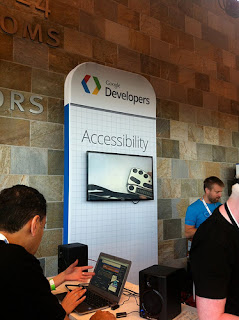Open Web Camp 4 took place last Saturday July 14, 2012. Turned out to be another great event organized by John Foliot (@JohnFoliot) of San Jose, California. This time, OWC was held at PayPal headquarters in San Jose (was held at Stanford the previous three years). Although the event covers different area of web development, several sessions concentrated on accessibility and others included accessibility as part of the content.
After helping with registration, I arrived a few minutes late to “HTML5: All about Web Forms” by Estelle Wyl (@standardista). The talk was a bit rushed, but packed with great information. Next, “Surf a GB with Glenda’s Thumb” was pretty interesting as Glenda Watson-Hyatt (@GlendaWH) demonstrated challenges of using a computer with a motor disability. She also asked attendees to try a web-surfing exercise while simulating a mobile impairment (by using only non-dominant hand with rubber band around fingers).
I regretted missing “Getting Your CSS Under Control” by Jonathan Snook. But instead I attended Denis Boudreau’s very relevant presentation, “Social Media Accessibility: Where Are We Today?“. This session was actually a replacement for Molly Holzschlag’s presentation; she couldn’t make the event due to TSA nonsense.
I finished the conference by attending “Unhiding The Truth Behind Hiding Content for Screen Reader Users” by Victor Tsaran (@vick08) and then a “game changing perspective” talk by Glenda Sims (@GoodWitch), pictured below.
The event was free in the past, and this year there was only a small $10 registration fee; the value is tremendous! In addition to the sessions, a t-shirt and lunch was provided to all attendees. And lunch was enjoyed by many outside in the nice Northern California weather by the pond on the beautiful PayPal campus. A nice time. I look forward to an OWC5 next year.

Related links:

